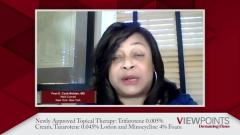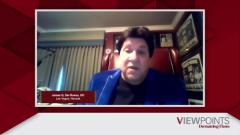
Newly Approved Topical Therapy: Clascoterone Cream 1% and Micronized Tretinoin 0.05% Lotion
Dermatology experts comment on the safety and efficacy of the newly approved topical therapies clascoterone cream 1% and micronized tretinoin 0.05% lotion.
Episodes in this series

Hilary E. Baldwin, MD: We have a couple of new tools to play with in our acne toolbox, so let’s briefly discuss the new kids on the block. Julie, I know that we have a recent approval of clascoterone 1% cream, which is an antiandrogen. How is this fitting into your armamentarium? How does it work?
Julie C. Harper, MD: It’s not fitting in yet because it’s not launched to us. It has been FDA approved, but it’s not something—at least as of the time of this recording—that we have available to us. It’s supposed to be available in the first quarter of 2021. It’s really interesting. I want people to think of it like this even though it’s not exactly this: Think of it like a topical spironolactone because it is going to competitively block the androgen receptor. It’s going to compete with testosterone or DHT [dihydrotestosterone]. If you think about, go back to the 4 main things that we’re trying to target in acne: follicular plugging, inflammation, C acnes [Cutibacterium acnes], and excess sebum.
Where would these antiandrogens potentially work? They would definitely work for sebum and inflammation. There’s a chance that, through an indirect effect, it might even have more impact than that. When you’re thinking about plugging this in, you’re thinking about sebum and inflammation first.
One of the unique things about this product is this: Because it gets high skin concentrations, not just high blood concentrations, this is going to be the first androgen blocker that we can use in not just women but men as well. That’s something unique about this. Again, hear that part: This is going to be an antiandrogen that we can safely use in men. In fact, in the studies, about 38% of the people in the studies were men.
In the studies, it was enrolled down to the age of 9, but this is a product that is now FDA approved down to the age of 12 for acne vulgaris. It’s nice that we’re going to have something that we can use in not just female patients but also male patients.
James Q. Del Rosso, DO: In addition, in the extension study, they included trunk. After they completed the typical phase 3 blinded pivotal trials up front, when they did the 1-year extension, they allowed treatment on the face and trunk. It was effective in both those locations.
Hilary E. Baldwin, MD: Interesting. Getting into some of the other newer agents, Fran, have you used the micronized tretinoin lotion? What do you think makes it different from other tretinoin formulations you might have used in the past?
Fran E. Cook-Bolden, MD: I have used it, Hilary. Tretinoin is a staple of the retinoids in treating acne; however, tolerability has always been a challenge in treating acne. The fact that it’s a lotion formulation, and this is the first lotion formulation of tretinoin, allows for easy spreading and use in large areas in addition to small areas of the body. In addition to using it on the face, we talked about how truncal acne is a real, prevalent thing, and we have to look for that and find that. This is a medicine that we can now use easily on the truncal areas. The unique lotion incorporates what they call a polymetric honeycomb matrix, which is a large, repeating matrix that helps provide a uniform distribution of both the tretinoin as well as moisturizing and hydrating ingredients. That way, with the tolerability issue, the dryness, and irritation that we’re used to talking about with retinoids that has been historic, we’re not finding it with this molecule. It makes it a great product for those with tolerability issues and those with sensitive or dry skin in our adult female patients. Those are the areas where I’m finding it helpful.
James Q. Del Rosso, DO: The other point about that particular formulation is that, in the studies, retinoids have typically been in the protocols. The patients have been told to apply at bedtime. In this case, they were not. The tretinoin lotion could have been used any time throughout the day. They didn’t necessarily have to apply it in the evening, and they got the efficacy that they got with patients applying it at any time during the day that they wanted to.
Hilary E. Baldwin, MD: This is very helpful, especially with our teenage population. I like to say this: see drug, use drug. The more rules you give the teenage patient, the less likely they are to use the stuff.
Newsletter
Like what you’re reading? Subscribe to Dermatology Times for weekly updates on therapies, innovations, and real-world practice tips.























